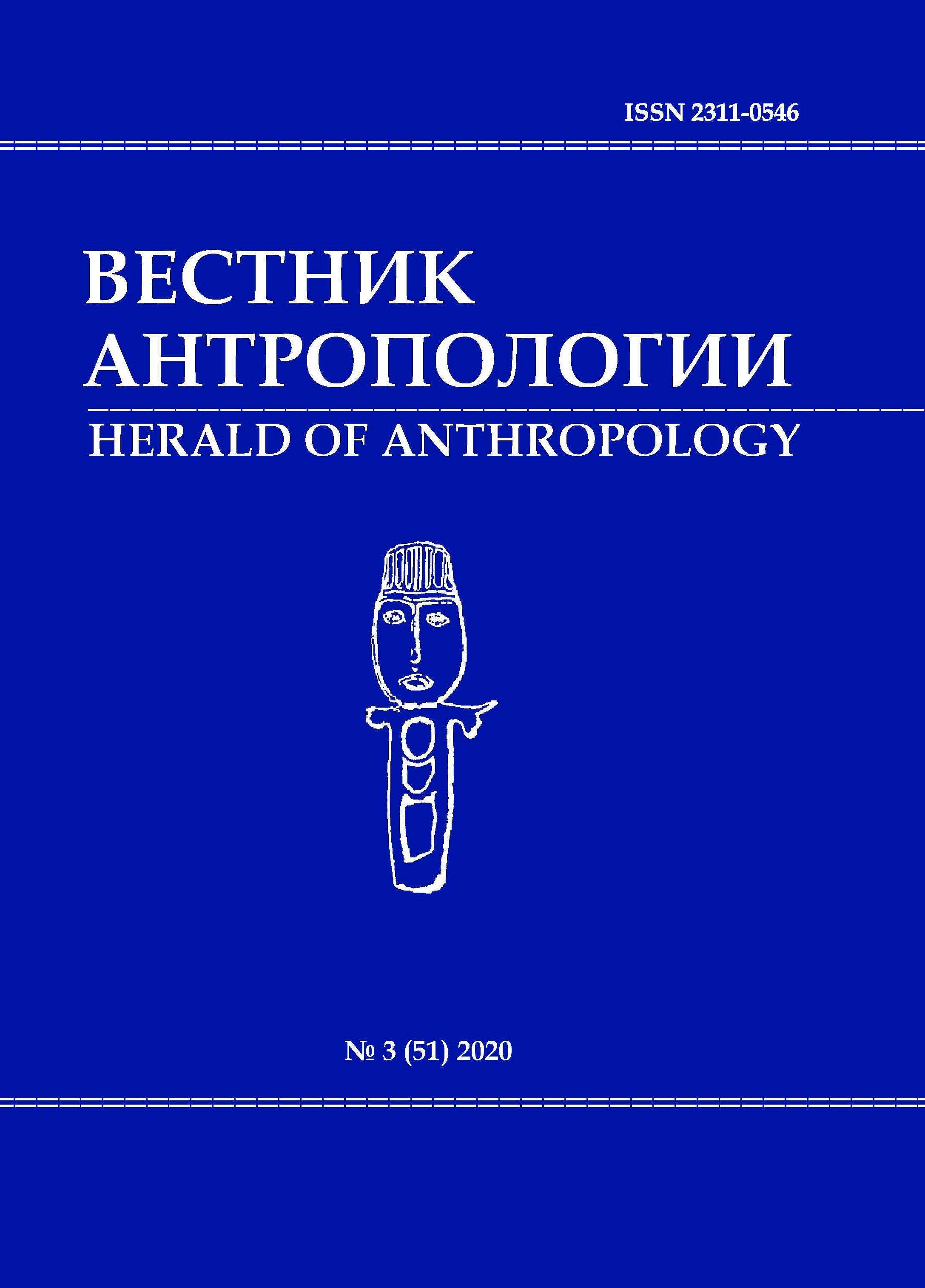A Modern Family. Anthropogenetic View of Reproductive Processes in Small and Medium-size Populations
DOI: 10.33876/2311-0546/2020-51-3/231-241
Keywords:
population, reproductive structure, reproduction, differential fertility, differential mortality, embryonic losses, selectionAbstract
The report presents a comparative analysis of anthropogenetic parameters in the populations of ethnic Greeks and Albanians of the Azov region, which contrast with the Pamirs and Kyrgyzs of the Pamir Mountains. In the highland Pamir populations of the Pastuf and Khuf (Rushan district of Gorno-Badakhshan Administrative Division (GBAD) of Tajikistan) and the Kyrgyzs of Murghab (Murghab district of GBAD), the main factors of microevolutionary changes are environmental conditions along with the influence of ethnic and confessional attitudes and cultural traditions. The pattern of reproduction is natural with unregulated fertility. A decrease in fertility is associated with the height of populations’ habitats above sea level. The populations of Azov – Krasnaya Polyana (ethnic Greeks speaking Rumeíka), Starolaspe (Tatar-speaking Greeks), and compactly populated Albanians of Devninskoye and Georgievka settlements underwent a demographic transition to the family planning system and strict artificial birth control. Populations surrounded by other ethnic groups have an urbanized pattern of reproduction not typical for groups of small and medium size. This population suffers from the effect of abrupt “aging”, with a small proportion of pre-reproductive age and a significant number of post-reproductive cohorts. Reproductive rates are low and the number is supported by migrations from other groups. The anthropogenetic analysis demonstrated that reproduction processes in populations depend on a set of biological and social factors, geographical conditions and environment
References
- Bodrosheva, N.G. Balinova, N.V. Spitsyna, N.Kh. 2018. Sravnitel’nyi antropogeneticheskii analiz protsessov vosproizvodstva populiatsii Gorno-Altaiska [Comparative anthropogenetic analysis of the processes of reproduction of the population of Gorno-Altaysk]. Vestnik Moskovskogo universiteta. Seriia XXIII. Antropologiia 3: 118–128.
- Crow, J.F. 1958. Some possibilities for measuring selection intensities in man. Human Biology 30: 1–13.
- Gracheva, A.S. Pobedonostseva, E.Iu. Udina, I.G. i dr. 2019. Territorial’naia podrazdelennost’ populiatsii megapolisa po etnicheskomu priznaku v sviazi s problemoi sozdaniia geneticheskikh baz dannykh. Sankt-Peterburg [The territorial subdivision of the population of the megalopolis by ethnicity in connection with the problem of creating genetic databases. St. Petersburg]. Russian Journal of Genetics. 55 (12): 1442–1450.
- Grigulevich, N.I. Spitsyna, N.Kh. Spitsyn, V.A. 2012. Osobennosti estestvennogo dvizheniia naseleniia Rossiiskoi Federatsii (biodemograficheskii analiz) [Features of the natural movement of the population of the Russian Federation (biodemographic analysis)]. Permskii meditsinskii zhurnal XXIX (2): 134–141.
- Jonston, F.E. Kesinger, K.M. 1971. Fertility and mortality differentials and their implications for microevolutionary change among the Cashinahua. Human Biology 43 (3): 56–364.
- Klegg, Dzh. 1981. Plodovitost’ i rannii rost [Fertility and early growth]. Biologiia zhitelei vysokogor’ia. Moscow: Mir: 78–135.
- Kucher, A.N. Kurbatova, O.L. 1986. Populiatsionno-geneticheskoe issledovanie differentsial’noi plodovitosti v gorodskom naselenii [Population genetic study of differential fertility in t he urban population]. Russian Journal of Genetics 22 (2): 304–311.
- Kurbatova, O.L. 2014. Demograficheskaia genetika gorodskogo naseleniia [Demographic genetics of the urban population]. PhD diss. abstrac. Vavilov Institute of General Genetics RAS.
- Kurbatova, O.L., Pobedonostseva, E.Iu. 2004. Urbanizirovannye populiatsii. Dinamika populiatsionnykh genofondov pri antropogennykh vozdeistviiakh [Dynamics of population gene pools under anthropogenic impact]. Pt. 5.2. / Red. Iu.P. Altukhov. Moscow: Nauka: 433–516.
- Mirrakhimov, M.M. 1981. Biologicheskie i fiziologicheskie osobennosti korennykh zhitelei vysokogor’ia Tian’-Shania i Pamira [Biological and physiological characteristics of the indigenous inhabitants of the highlands of the Tien Shan and Pamirs]. Biologiia zhitelei vysokogor’ia. Moscow: Mir, 329–349.
- Muller, H.J. 1954. Manner of Dependence of “Permissible Dose” of Radiation on Amount of Genetic Damage. Acta Radiologica 41: 5–20.
- Posukh, O.L. Vibe, V.P. Sukernik, R.I. 1990. Geneticheskoe i ekologicheskoe izuchenie korennykh zhitelei severo-vostoka Sibiri. Soobshchenie 3. Demograficheskaia struktura trekh sovremennykh populiatsii evenov Iakutii [Genetic and ecological study of the indigenous people of the North-East of Siberia. Communication 3. Demographic structure of three modern populations of Evens in Yakutia.]. Russian Journal of Genetics 26 (9): 1628–1636.
- Spitsyn, V.A. Bets, L.V. Anikeeva, A.V. Spitsyna, N.Kh. 1997. Vliianie sredovykh i geneticheskikh faktorov na urovni testosterona. estradiola i somatotropnogo gormonov u gortsev Pamira. [The influence of environmental and genetic factors on testosterone levels. estradiol and somatotropic hormones in the Pamir highlanders]. Vestnik RAMN 7: 46–50.
- Spitsyn, V.A. Novoradovskii, A.G. Spitsyna, N.Kh. Parik ,Iu.Ia. 1989. Polimorfizm α1–antitripsina v populiatsiiakh Pamira. Reproduktivnaia kompensatsiia – vozmozhnyi mekhanizm podderzhaniia geneticheskogo raznoobraziia populiatsii po genam PI [Polymorphism of α1 – antitrypsin in Pamir populations. Reproductive compensation is a possible mechanism for maintaining the genetic diversity of a population for PI genes.]. Russian Journal of Genetics XXV (12): 2218–2224.
- Spitsyna, N.Kh. 2006. Demograficheskii perekhod v Rossii. Antropogeneticheskii analiz [Demographic transition in Russia. Anthropogenetic analysis.]. Moscow: Nauka. 212 p.
- Spitsyna, N.Kh. 1993. Problemy istoricheskoi genetiki [Problems of Historical Genetics]. Moscow: Izdatel’stvo IEA RAN.
- Spitsyna, N.Kh. 2004. Antropogeneticheskoe izuchenie grecheskikh i albanskikh populiatsii Priazov’ia. Greki Rossii i Ukrainy [Greeks of Russia and Ukraine]. St-Petersburg: Aleteiia. 542-549.
- Spitsyna, N.Kh. 2009. Reproduktsiia – unikal’nyi indikator biologicheskogo i sotsial’nogo zdorov’ia obshchestva [Reproduction is a unique indicator of the biological and social health of society]. Moscow: V mire nauki, 8: 34-40.
- Vserossiiskaia perepis’ naseleniia 2010 (Elektronnyi resurs) [All-Russian Population Census 2010 (Electronic resource)]. http://www.perepis-2010.ru. Data obrashcheniia 27.02.2020
- Write, S. 1938. Size of population and breeding structure in relation to evolution. Sciece 87: 430–431





















